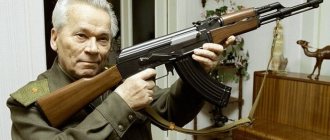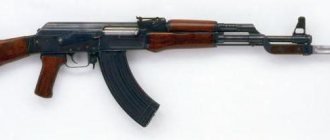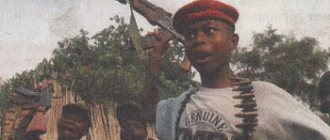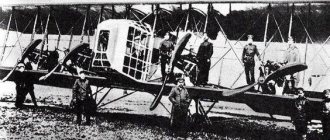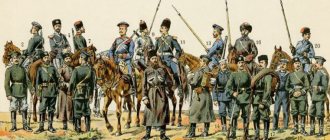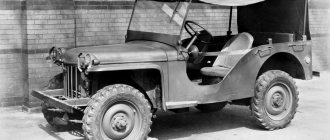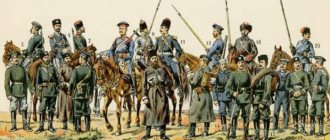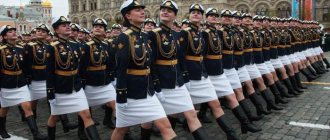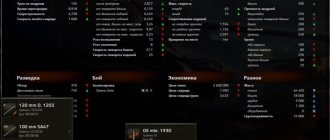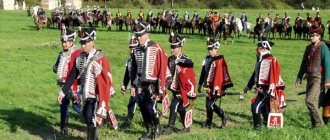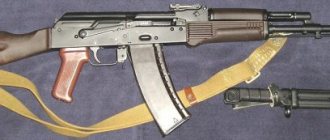Introduction
The history of the AK-74 and RPK-74 is inextricably linked with the life of its designer, Mikhail Kalashnikov.
His very first works - a submachine gun, a light machine gun - did not get a start in life, but the lessons learned in the process of their creation allowed Mikhail to reach a new qualitative level in his work on the legendary model of the AK assault rifle.
The tender for the design of the machine required the submission of general view drawings of components and parts, strength calculations of the clamping device and expected performance characteristics. Second place went to the project of M.T. Kalashnikov, the first is the project of Colonel N.V. Rukavishnikov, and the third is the project of Captain K.A. Baryshev, military designer of the small arms division. Designers had to champion metal designs. At the end of 1945, Kalashnikov was sent to the Kovrov plant, where he was assisted by designers, technologists and workers who were supposed to help him in the manufacture of prototypes of automatic rifles. Everything needed was found. During the war years, the plant was fully occupied with the production of such weapons.
It took about ten months to produce three samples. Kalashnikov came to the shooting range with two of them and presented themselves at the first stage of competitive testing. In addition to his sample, test rifles were presented by famous designers Degtyarev, Shpagin, Rukavishnikov, Afanasyev, Bulkin, Korobov and two or three other young gunsmiths.
And after long tests, the long-awaited and desired conclusion of the commission was to recommend for entry into service the 7.62-mm assault rifle, developed by Staff Sergeant M.T. Kalashnikov. In 1947, by Decree of the Council of Ministers of the USSR dated June 18, 1949 No. 2611-1033ss, the AK47 assault rifle was adopted by the Soviet Army and Navy.
In early 1948, Kalashnikov was sent to Izhevsk to work at the Maxim machine gun factory during the war. The “parent” himself, 29-year-old Kalashnikov, took direct and daily participation in the development and production of the first industrial serial machine guns.
The presence of ready-made production facilities made it possible to quickly master the production of the AK47 rifle and produce it in large quantities in the first years. The report data shows that the machine-building plant supplied more than 80,000 automatic rifles to the GAU in the first year of production, with production volumes increasing significantly in subsequent years.
The AK47 series was introduced without a muzzle device. During experimental shooting, a simple muzzle compensation configuration was discovered that prevented the shoulder support from retracting from the shooter when firing. During the first decade of the assault rifle, other important changes were made to its characteristics and capabilities associated with the introduction of new technologies and materials. Then designers and technologists once again proved that an embossed receiver will be less labor-intensive than an embossed one. In anticipation of the transition to the production of a modernized AKM assault rifle, an inter-cycle retarder design was developed, which made it possible to slightly increase productivity. At that time, a new bayonet, a device for silent and free-floating shooting, and sights that glow in the dark were introduced. All good design solutions were taken into account and included in the drawings of the AKM, which was in service with the Soviet Army one and a half times longer than its predecessor.
When developing design changes to be included in the AKM drawings, special attention was paid to standardization of parts, their interchangeability, and the strength of the connecting dimensions. Subsequently, during the development and introduction of new weapons based on the AK47, this approach turned out to be invaluable when moving from model to model for both the production and operation of weapons.
After the introduction of the AKM assault rifle into production, the Kalashnikov group, at the request of the GRAU team, developed a light machine gun according to the proven AK design. The decision was dictated by the desire to have one 1943 gun in the army department. The light machine gun has established itself as the most rational design with standardization of the parts of the trigger mechanism and bolt group. Some parts had to be slightly hardened to ensure better survivability. This required lengthening the barrel, introducing a lightweight bipod, thick-walled receivers, a larger-capacity magazine, and modifying stock and stock parts. Other design groups were also tasked with developing a light machine gun. In addition to the unconditional preservation of the combat characteristics achieved using the existing 7.62-mm Degtyarev rifle, it was necessary to significantly reduce the labor intensity of its manufacture and the weight of the RPG machine gun. As tests at the test site showed, the Kalashnikov light submachine gun (RPK) best met these requirements. The only source of power for submachine guns and machine guns in service with the army department was especially bribed. The cartridge magazines of the samples were interchangeable. The testing commission recommended acceptance of the Kalashnikov manual assault rifle. Serial production of the RPK was entrusted to the Vyatsko-Polyansky Machine-Building Plant.
At the end of 1958, Kalashnikov began developing the so-called “single-barreled pistol” chambered for a 7.62 mm rifle. The drawings were developed in a short time. 25 machine guns were produced and were to be submitted for testing. In October 1961, the PK machine gun was accepted into the army. In subsequent years, machine guns for armored vehicles were developed based on the PK machine gun.
At the end of the 1960s, demands increasingly began to be placed on the development of a cartridge and, accordingly, on weapons of 5.45 - 5.6 mm caliber. At that time, the Americans were already producing the Stoner M16A1 5.56 mm automatic rifle. It was assumed that a smaller caliber bullet would have a number of advantages over a three-wire caliber bullet, such as increased initial velocity, anti-structural trajectory, accuracy and a large number of automatic shots. And the corresponding reduction in the mass of the cartridge made it possible to significantly increase the supply of ammunition. Fatherland cartridge designers were probably working on a 5.56mm cartridge around a bullet of this diameter. Izhevsk gunsmiths produced ballistic weapons for large-scale testing of the new cartridge.
Without waiting for the reduced caliber cartridge to be fully developed, GRAU invites tenders and provides technical specifications for the construction of reduced caliber machines to plant designers and design bureaus. M.T. Kalashnikov and his team decided to develop an automatic rifle based on the AKM. The long and persistent search was successful. By Decree of the Central Committee of the CPSU and the Council of Ministers of the USSR dated March 18, 1974 No. 049, the AK74 assault rifle of 5.45 mm caliber and the RPK74 light machine gun were put into operation.
About a year after the industrial development of automatic rifles and machine guns, the idea of developing a 5.45 mm shortened machine gun was born. It was developed by the designers of the Kalashnikov department. The lead designer was S.N. Furman, who had previously been a deputy senior military officer at the same plant. Based on the AK74, Furman's group determined the barrel length where the muzzle velocity of a 5.45 mm bullet when fired from an AKM was the same as that of a 7.62 mm bullet. To create a short rifle called the AKC74U, changes were required to the design of the rifle.
The first idea to create a hunting carbine based on the AKM was born in 1993 in the wake of the inevitable reduction in the production of assault rifles. The possibility of such a step is obvious. The production of civilian weapons using ready-made technology with parts of the AKM machine gun was profitable and profitable. Over the years, a number of AK101, 102, 103, 104, 105 have been developed in various calibers and applications.
In 1997, the Russian public, military, weapon developers and manufacturers celebrated the 50th anniversary of the AK47 assault rifle, on the basis of which all other automatic small arms of the Kalashnikov system were developed.
Such a long service of the Soviet Army, the then armed forces of Russia and other states with Kalashnikov assault rifles and machine guns testifies to the perfection of the design and the undeniable combat qualities of the weapon and at the same time the world recognition of the creative talent of the designer.
Victory at the competition and launch of mass production
The AK-47 has become a simple and reliable assault rifle that will not let soldiers down in difficult times / Photo: vashsad.ua
As a sergeant, the designer knew firsthand that ordinary soldiers do not graduate from military academies. That is why Kalashnikov wanted to make a simple and reliable machine gun that would not fail in difficult times. Mikhail Timofeevich returned to Kovrov and at plant No. 2, together with gunsmith Alexander Zaitsev, created a new version of the AK, which underwent major changes in appearance and mechanism.
In 1948, final tests took place. The AK-47 was recognized as the most reliable machine gun, although it did not have the required parameters. However, this did not prevent the weapon from becoming the best, and Izhevsk Plant No. 524 decided to produce a pilot batch of new machine guns. So Mikhail Timofeevich went to Izhevsk, where he began producing weapons.
Since 1949, Kalashnikov assault rifles have been adopted by the USSR army / Photo: cdn3.russian7.ru
The plan to produce 1,500 units of assault rifles was completed within the specified time frame. The Kalash successfully passed the tests and in 1949 they armed the Soviet army. Then the weapons were officially given the names AK and AKS (with a folding stock). As Mikhail Timofeevich said, “a soldier made a weapon for a soldier.”
Designation and combat characteristics of 5.45 AK-74 and RPK-74
The 5.45 mm Kalashnikov assault rifle is a single weapon, the 5.45 mm Kalashnikov assault rifle is a rifle department rifle. They are designed to destroy manpower and destroy enemy firearms. To defeat the enemy in close combat, a bayonet-knife is attached to the machine gun. For shooting and observation in natural night light conditions, in addition to the AK74N, AKS74N assault rifles and RPK74N, RPKS74N* machine guns, universal night vision devices (UNPU) are used.
Shooting is carried out with conventional cartridges (with a steel core) and tracer bullets.
The machine gun fires automatically or with one hand. Automatic fire is the most important type of fire: shooting is carried out in short (up to 5 shots) and long (from a machine gun - up to 10 shots, from a machine gun - up to 15 shots) lines and continuously. Firing is carried out from a box magazine with a capacity of 30 rounds for the cannon and 45 rounds for the machine gun. Automatic and machine gun magazines are interchangeable.
The visibility of the machine gun (machine gun) is 1000 meters. The most effective fire on ground targets: Machine gun firing range up to 500 m, machine gun firing range up to 600 m, and for airplanes, helicopters and paratroopers, machine gun and machine gun firing range up to 500 m. Targeted fire from machine guns and machine guns is aimed at targets of ground groups at a distance up to 1000 meters. Direct firing range: on the chest 440 m, on the running figure 625 m; chest 460 m and running figure 640 m.
The firing rate is about 600 rounds per minute.
Combat speed: for shots in pushes from a submachine gun up to 100, from a machine gun up to 150 rounds per minute; for single shots from a submachine gun up to 40, from a machine gun up to 50 rounds per minute
Weight of the vehicle without a bayonet knife with a plastic magazine with cartridges:
- AK.74-3.6 kg; AK74N-5.9 kg; AKS74-3.5 kg;
- AKS74N - 5.8 kg. The weight of the bayonet knife in the sheath is 490g.
- Weight of the machine gun with a plastic magazine loaded with cartridges: RPK74-5.46 kg;
- RPK74N-7.76 kg; RPK74-5.61 kg; RPK74N-7.91 kg.
Let's compare some ballistic and design data of our 5.45 AK-74 rifle with the M16A1 rifle used by the US Army and the M16A2 rifle.
The difference between the M-16A1 and A2 is that the latter is capable of firing 2-3 rounds of continuous fire, shorter and lighter. Cartridge SS109, stronger than regular 5.56. The M-16A2 also has a reduced cutting pitch from 305mm to 178mm (as an accessory to the SS109 itself). The CAR-15 is strictly speaking a carbine, and somewhere in the late 70s, the so-called civilian version, which does not have an automatic firing mode and was previously intended for sale to the general public. And the CAR-15A3 with a 16-inch barrel (229 mm pitch) is actually no different from the AKM in size. When we talk about military weapons, we must talk about the M4 carbine, which is used by special forces, airborne troops and combat and special equipment. The M4 is actually based on the M-16A2 rifle, not the AR-15 rifle in any of its variants. However, the AR-15/M-16 family is so diverse in its modifications that you have to compare it with the AK family.
It already includes the AR-15/M-16 family:
- M635 - submachine gun;
- M655 - carbine;
- M703 - assault rifle;
- M711 - assault rifle;
- M723 - Carbin;
- M731 - Machine gun;
- M733 - small machine gun;
- M741, light machine gun;
- and so on.
Professionals - shooting accuracy, ease of aiming, easy shutter change, etc. safety in use, low cost of ammunition and their variety. Minus - fear of dirt, unlike the AK, does not withstand heavy blows.
Compared to the AK-74 and M16A1, the AK is almost as good as the American attack aircraft, in some respects even better. But the M16A2 has increased accuracy due to its weight and extension to 510 mm. The rifle comes in two variants: single/continuous shot or single/fixed shot with three shots each. The rifle has a sight 800 m long, adjustable in two planes. Of course, it should be remembered that the M16A2 was created as a counterweight to our AK-74, and the time difference in its production is up to 10 years.
General structure and principle of operation of the automatic system
An automatic rifle (machine gun) consists of the following main parts and mechanisms:
- Barrel with receiver, sight, butt and pistol grip;
- receiver covers;
- Frame with gas piston pin;
- Close;
- return mechanism;
- Gas pipe with barrel shell;
- impact trigger mechanism;
- ceva;
- business.
In addition, the machine gun has a muzzle brake compensator and a bayonet, while the machine gun has a flash suppressor and a bipod.
The kit includes an automatic rifle (machine gun): accessories, belt and bag (the machine gun has two pockets) for magazines; .the kit of the machine gun (machine gun) with a folding stock also includes a pocket for the machine gun (machine gun) with a pocket for magazines, and the kit of the machine gun (machine gun) with a night sight also includes a universal night sight.
The automatic action of an assault rifle (machine gun) is based on the energy of powder gases ejected from the barrel into the gas chamber.
When firing, part of the powder gases following the bullet is directed through a hole in the barrel wall into the gas chamber, pressed against the front wall of the gas piston and throws the piston and bolt frame to the rear position. When moving the bolt back, it unlocks the breech, pulls the cartridge case out of the cartridge and throws it out, the bolt presses the return spring and pulls the trigger (places it on the self-loading plate).
Under the action of the piston mechanism, the breech of the bolt returns to the forward position, while the bolt sends another cartridge from the magazine into the chamber and closes the barrel, and the breech of the bolt removes the whisper of self-loading from the trigger guard. The trigger turns into combat action. The bolt is locked by rotating the bolt to the right around its longitudinal axis, causing the bolt lugs to close behind the receiver.
When the translator is set to automatic fire, shooting continues as long as the trigger is pressed and there are cartridges in the magazine.
If the translator is mounted on a single shot, then when you press the trigger, only one shot is fired; To fire the next shot, the trigger must be released and pulled again.
A distinctive feature of the M16A1 and A2 AKs in action mode is the firing of 3 rounds, which is carried out by inserting a ratchet into the trigger mechanism. The ratchet rotates 60 degrees with each reverse movement of the hammer through the locking frame, and with each 180 degree rotation of the trigger, the ratchet moves the hammer from a self-loading function to a whisper trigger. The trigger is then released and pulled again to resume fire.
Zevia, buffer and pistol grips are made of more durable plastic with improved thermal insulation properties. The muzzle device deflects propellant gases into the upper right side of the barrel to reduce their emission and reduce the velocity to a level that prevents the formation of dust. A protective screen is installed behind the receiver window to deflect the ejected shell casing forward to prevent the shell casing from entering the face from the left shoulder during firing. The front part has a square section and is height adjustable. The folding rear sight has two diopters and is adjustable in height and direction using two screws with steering wheels. The handwheels have fixed positions so that the sight can be adjusted with a few clicks. The large diopter (5 mm) diameter is used when shooting in poor visibility conditions or at moving targets at a distance of up to 200 m, the small one (1.8 mm) is used for daytime shooting at a distance of 300-800 m (3/8 systems - 300 m, "4" - 400 m, "5" - 500 m, "7" - 700 m) The M16A2 was equipped with an M9 bayonet knife, which is equally suitable for the M16 and M16A1.
Research project “Kalashnikov assault rifle (AK-47)”
Slide 1
6th Scientific and Practical Conference of Students of School No. 2 Section: Technology Research project “Kalashnikov assault rifle (AK-47)” The work was completed by: Students of class 7A Danil Ushakov, Kiril Khaleev, Dmitry Birsh, Yaroslav Suprun. Head: 1st category technology teacher V.V. Kunaev Ershov 2015
Slide 2
In our world, weapons currently play a very huge role! Since ancient times, man has invented weapons for hunting, for obtaining food, for warfare, etc. But with every passing year, people changed and the weapons themselves changed. In any country there is a very huge list of weapons, but we will only talk about some
Slide 3
We have chosen the most dangerous and reliable weapons: Nuclear weapons Ballistic missiles High-precision weapons And we would like to highlight the invention of our designer M.T. Kalashnikov assault rifle AK-47
Slide 4
Nuclear weapons (or atomic weapons) are a set of nuclear weapons, means of delivering them to the target and control means. Refers to weapons of mass destruction along with biological and chemical weapons. Nuclear ammunition is an explosive weapon based on the use of nuclear energy released as a result of an avalanche-like nuclear chain reaction of fission of heavy nuclei and/or thermonuclear fusion reaction of light nuclei.
Slide 5
A ballistic missile is a type of missile weapon. Most of the flight is carried out along a ballistic trajectory, that is, it is in uncontrolled movement (see Ballista). The required speed and direction of flight are communicated to the ballistic missile during the active phase of the flight by the missile's flight control system. After the engine is turned off, the warhead, which is the payload of the rocket, moves along a ballistic trajectory the rest of the way. Ballistic missiles can be multistage, in which case, after reaching a given speed, the spent stages are discarded. This scheme allows you to reduce the current weight of the rocket, thereby increasing its speed. Ballistic missiles can be launched from a variety of launchers: stationary - silo or open, mobile - on non-wheeled or tracked chassis, aircraft, ships and submarines.
Slide 6
A high-precision weapon is a weapon, usually controlled, capable of hitting a target with a given (and fairly high) probability with the first shot (launch) at any range within its reach. As a result of the ongoing scientific and technological revolution, it has become possible to create high-precision weapons, which, according to a number of military experts, will determine the nature of the future war - the war of the sixth generation. Allows you to deliver extremely accurate strikes on attacked objects (up to hitting the required window of a given structure).
Slide 7
From the entire list of our project, we settled on the choice: Kalashnikov-47 assault rifle.
Slide 8
History of the creation of the AK-47 On July 15, 1943, a meeting of the Technical Council under the People's Commissariat of Defense of the USSR took place. Based on the results of a study of the captured German MKb.42 assault rifle chambered for the world's first mass-produced intermediate cartridge 7.92 mm Kurz of 7.92×33 mm caliber, the management came to the conclusion: it is urgently necessary to develop a domestic cartridge similar to the German one, as well as weapons for it. It was believed that the new weapon system would provide infantry with the ability to fire effectively at distances of up to 400m. It was supposed to include a light machine gun, a machine gun, self-loading and repeating non-automatic carbines. The creation of this type of weapon would make it possible in the future to replace almost the entire arsenal of individual small arms in service with the Workers' and Peasants' Red Army. In 1944, based on the results of tests for further refinement. The development of an automatic machine designed by Alexey Sudaev AS-44 was selected for further development. However, the creator of the AS-44 soon died, so work on the model was stopped. In 1946, Mikhail Timofeevich Kalashnikov took part in the next round of tests. Soon his project was approved and the first version of the experimental Kalashnikov AK-46 assault rifle was manufactured. The results of the second competitive round revealed: the AK-46 is unsuitable for further development. For the next round, along with the Bulkin (TKB-415) and Dementyev (KBP-520) assault rifles, Kalashnikov presented an almost new model (KBP-580). As a result, the commission recognized the Kalashnikov assault rifle as the most reliable, and already in mid-1949 two variants of the assault rifle, “7.62 mm Kalashnikov assault rifle” and “7.62 mm Kalashnikov assault rifle with folding stock,” were adopted for service. In subsequent years, the AK design was constantly improved. In 1959, the AKM “7.62-mm modernized Kalashnikov assault rifle” was adopted.
Slide 9
Next, my group and I decided to characterize the machine itself and its creator.
Slide 10
Characteristics of the AK-47 The assault rifle consists of the following main parts and mechanisms - a barrel with a receiver, sights, butt and pistol grip; — receiver covers; - bolt carrier with gas piston; - shutter; — return mechanism; - gas tube with receiver lining; — firing mechanism; - handguard; - store. In addition, the machine gun has a muzzle brake-compensator and a bayonet. The machine kit includes: accessories, a belt and a bag for magazines; .the set of the machine gun with a folding butt also includes a case for the machine gun with a pocket for the magazine, and the set of the machine gun with a night sight also includes a universal night sight. The automatic operation of the machine gun is based on the use of the energies of powder gases diverted from the barrel bore into the gas chamber .
Slide 11
Kalashnikov Mikhail Timofeevich Mikhail Timofeevich Kalashnikov is a Russian designer of small arms, twice Hero of Socialist Labor (1958, 1976), Hero of Russia (2009), holder of the Order of St. Andrew the First-Called (1998), laureate of the Lenin Prize (1964), Stalin Prize (1949), State Russian Prize (1998), Doctor of Technical Sciences (1971), Lieutenant General (1999), Deputy of the Supreme Council of the USSR (1950-1954); creator of the Kalashnikov assault rifle. Mikhail Kalashnikov was born on November 10, 1919, in the village of Kurya, Kurya district, Altai region. Misha was the seventeenth child in a large peasant family. In his autobiography, he wrote: “My homeland, the steppe Altai village of Kurya, is located along the Loktevka River, sixty kilometers from the Barnaul-Semipalatinsk railway line, and it is not surprising that I first saw a “live” steam locomotive only in 1936, when I turned 17 years... In 1930, his father was recognized as a kulak and the Kalashnikovs were evicted from the Altai Territory. In 1936, after graduating from the ninth grade of high school, Mikhail went to work as a student at the railway depot of the Matai station in Kazakhstan, and later worked in Alma-Ata as a technical secretary of the Turkestan-Siberian Railway department. In 1938, he was drafted into the Red Army, was sent to the Kiev Military District, graduated from the school of tank driver mechanics, and served in a tank regiment in the city of Stryi in Western Ukraine. In his army service, Kalashnikov showed himself as an inventor. He developed an inertial counter to count the number of shots fired from a tank gun, made a special device for the TT pistol to increase the efficiency of firing from it through slits in the tank turret, and created a tank engine resource meter. With the latest invention, Junior Sergeant Kalashnikov was sent by the district commander, Army General Georgy Konstantinovich Zhukov, to Moscow, and from there to Leningrad Plant No. 174 named after Voroshilov to put the invention into production. With the beginning of the Great Patriotic War, senior sergeant Kalashnikov took part in battles as a tank commander. In October 1941, in the battles near Bryansk, he was seriously wounded and shell-shocked.
Slide 12
The most interesting and most important thing is that there is no analogue of this machine in the world.
Slide 13
Safety Precautions 1. Do not turn on the machine without the teacher's permission. 2. Securely fasten the tailstock of the machine. 3. Check the workpiece to ensure that it does not have cracks. 4 . Securely fasten the workpiece. 5 . Before working on a lathe, prepare the workplace: remove all unnecessary things from the machine and around it, prepare and arrange only the necessary tools and devices. 6. Check the working tool. The handles should not have cracks and should be firmly seated. 7. Tuck in clothes. 8 . Before starting the machine, put on safety glasses. 9 . During the turning process, periodically stop the machine and press the part with the center of the tailstock, eliminating gaps. 10 . During work, do not be distracted, do not move away from the machine. eleven . All adjustment operations should be carried out only with the machine switched off and stopped. 12 . Do not process the part near the trident. 13 . Do not stop the workpiece with your hands. 14 . Report any problems to the teacher.
Slide 14
Defining the needs of the AK-47 is a remarkable creation in history. Many sources claim that there is no analogue to the machine. In Russia, this machine was and is the best invention
Slide 15
So the goal is clear: It is necessary to make a model of the machine. Based on the goal, the following tasks arise: - Develop a product manufacturing plan - Select a material, - Develop a product design, - Make a layout, - Analyze the product
Slide 16
Research. Customer Selection of design Scope of application Selection of material Need Number of products What to do and for whom? Problems. How to do? Estimate. Preparation time.
Slide 17
Selection of materials: We thought for a long time, but still came to the same conclusion that we would use pine.
Slide 18
Manufacturing methods To make a model we will need the following equipment and tools: 1. Chisels 2. Wood lathe 3. Hammer 4. Small nails 5. Wood saw 6. Glue moment 7. Veneers 8.Tin
Slide 19
A list of criteria that a gift for your brother must meet. 1 . Name - mock-up of AK-47 2. Purpose – layout for a school exhibition 3. Market (buyers) age is not limited 4. Production – single product 5. Dimensions – the layout should be medium in size. 6. Material – pine, tin 7. Manufacturing methods: wood turning and varnishing. 8 . Environmentally friendly - the material can be recycled
Slide 20
Self-assessment of students about the manufactured product After the practical part was over, we carried out an analysis of the product’s compliance with the requirements that were initially set for the layout. This is compliance with the problem, efficiency. The layout turned out to be beautiful, durable and convenient.
Slide 21
Technological map Name Drawing What happened Instruments Receiver with forearm and butt. 540mm 120mm Lathe, chisels, files, hammer, sandpaper, wood saw. Gas tube with barrel lining. 120mm 20mm Wood saw, lathe, chisels, emery cloth. Shop . 5mm 200mm 100mm Drill, veneers, lathe, chisels, sandpaper. Handle. 75mm 45mm Lathe, chisels, wood saw, emery cloth. Trunk. 220mm 20mm Lathe, chisels, sandpaper
Slide 22
Conclusion The Kalashnikov assault rifle - as our assault rifle was dubbed abroad - is today the most common type of infantry automatic weapon. Edward Clinton Izell, former president of the Institute for Small Arms and International Security Research (USA), professor and author of the famous work “The History of the AK47,” estimates that more than 50 million have been produced worldwide since mass production began in 1948 to the present day. Kalashnikov assault rifles of various modifications. For comparison, it is noted that the closest competitor to the AK family, the Eugene Stoner M-16 automatic rifle, has about 10-12 million. Actively used in combat operations in Vietnam, Afghanistan, Nicaragua, on the African continent, in the Middle East and dozens of other “hot spots” on the planet, Kalashnikovs have repeatedly confirmed their reputation as weapons with outstanding reliability, efficiency and simplicity of design. AK is not just a symbol of a reliable weapon. He saved the lives of many in the hottest, most severe battles.
Features of the manual pistol device of the machine
The design and design features of the RPK-74 AK-74 are determined by their purpose. Firstly, the RPK has increased shooting accuracy. This is achieved due to the length of the barrel (AK - 415 cm, RPK - 590 cm) or the length of the rifled part of the barrel (AK - 372 cm, RPK - 549 cm). As a result, the initial bullet speed was increased (AK - 900 m/s, RPK - 960 m/s).
There are also differences in scope design.
The machine gun has a slot for the target strip and a scale with ten divisions on the wall of the slot, each of which corresponds to the two thousandth range. The heel of the machine gun has a grooved rod, a screw with a flywheel, a spring, a washer and a pin.
The bipod is attached to the front of the barrel to facilitate shooting in the RPK.
It has a base, two legs with sliders for stopping in the ground and protrusions for fixing the legs in the folded position, a spring for unfolding the legs, a spring clip on the left leg for fixing the legs in the folded position. The bipod cannot be removed from the machine gun.
The AK has a muzzle brake at the end of the barrel to increase the firing rate of the receiver and reduce recoil energy. With the RPK, the increased heap is achieved at the expense of barrel length, so the RPK design is not a muzzle brake compensator. A fire extinguisher is used to reduce the size of the flame during a shot. It has a thread for screwing onto the barrel, five tips for fixing and five longitudinal holes for gas removal.
